Best sleeping bags 2022: for warm, comfortable nights at camp
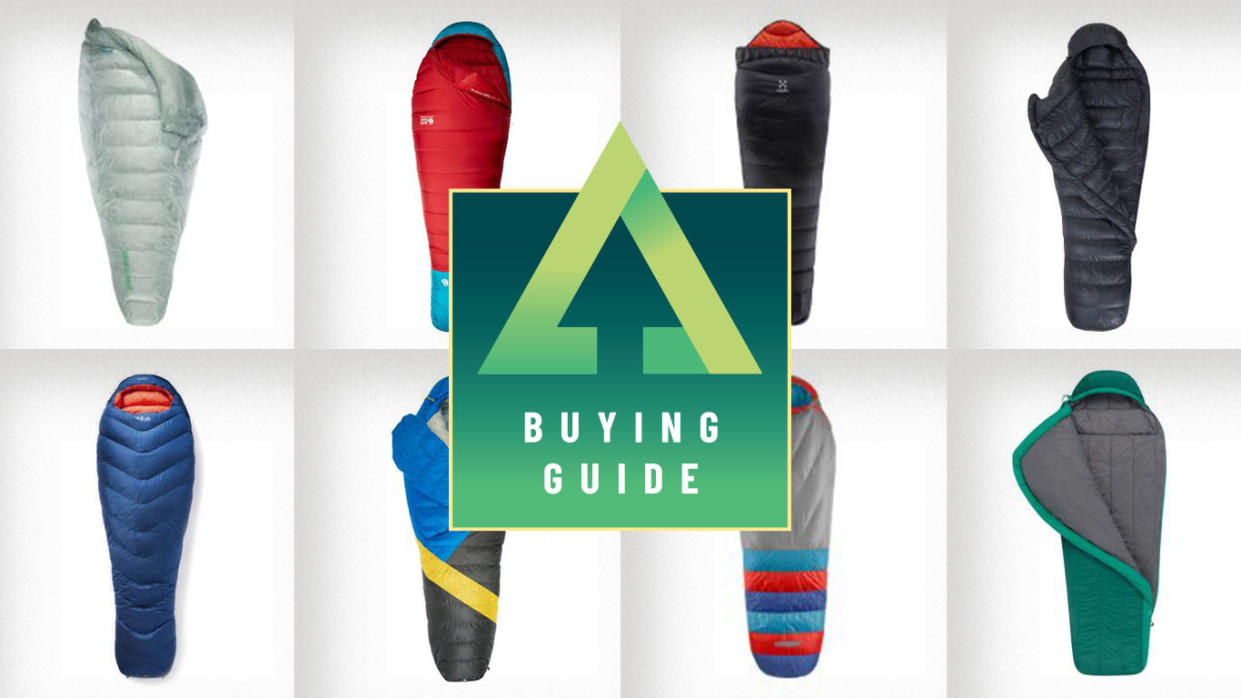
Having one of the best sleeping bags for your camping trips this fall could be the difference between a blissfully cozy sleep or a night spent in cold discomfort. A sleeping bag is, along with your tent, the most crucial element of any camping trip, especially when the mercury starts falling after the heady days of summer.
The best sleeping bags use a natural or synthetic fill to insulate you, trapping your body's warmth and keeping you toasty during the night. Natural fill is generally goose or duck down, which has the advantage of a high warmth to weight ratio and the ability to compress down to a small size in your pack.
This makes down sleeping bags the go to for hikers setting out into the backcountry with their best camping tent. Synthetic insulation is usually cheaper, faster drying and has the advantage of not involving animals in its creation. However, they are made of plastics that will never biodegrade, so looking for a bag that contains recycled materials is a good option to keep the environmental impact of your purchase down.
In this guide, we feature the best sleeping bags you can buy, from winter ready cocoons to lighter models designed for summer.
Best lightweight sleeping bags
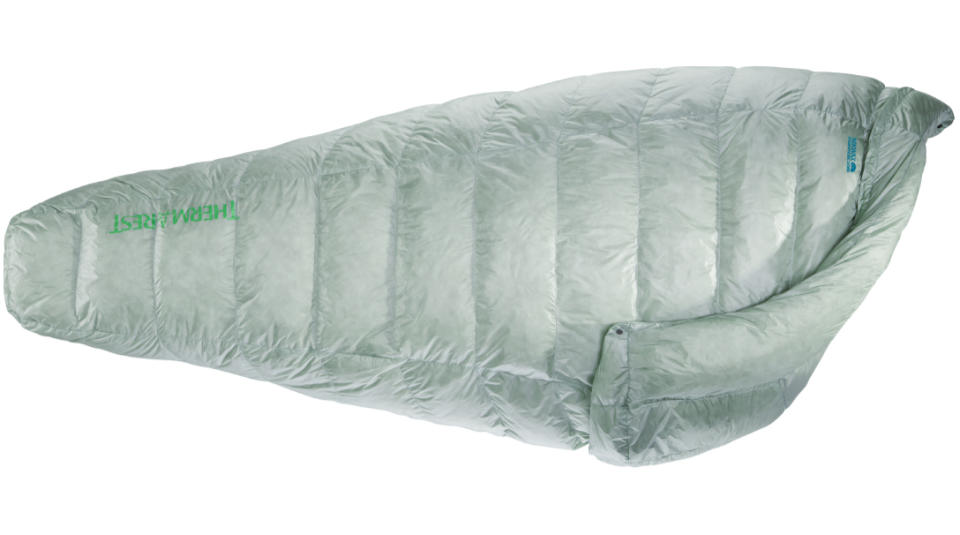
Therm-A-Rest Vesper 32 Quilt
Lightweight camping quilt for multiday hikers, bikepackers, fastpackers and racers who like to move fast along the trails
Weight: Regular: 425g / 15 oz; Long: 490g / 1lb 1oz | Length: Regular: 191cm / 6ft 3in; Long: 201cm / 6ft 7in | Pack size: 13 x 15cm / 5 x 6in | Fill: RDS-certified 900 Fill Goose Nikwax Hydrophobic Down | Comfort: 5°C / 41°F | Limit: 0°C / 32°F
Ultralight
Ultra-packable
Not suitable for cold weather
Relatively expensive
Made for backpacking and bike packing, Therm-A-Rest’s thermally efficient quilt uses box-baffled construction, so it’s like a sleeping bag without a full enclosure, so you can stick your feet out the bottom when they’re too warm. The resulting product provides almost as much warmth as a normal bag, for less weight.
The quilt’s snap neck closure, perimeter side baffles, and insulated footbox (where you can tuck your feet away) keep the warmth-to-weight ratio high for backcountry adventures. So does the 900-fill Nikwax Hydrophobic Down (humanely harvested), which stays drier and maintains loft 60 times longer than untreated down. Mesh walls in the bag maximize loft and minimize cold spots. And, to keep drafts out, the bag connects to a Therm-A-Rest mattress with the brand’s Synergy Link connectors. The best sleeping bag for traveling light and sleeping cool.
Read our full Therm-A-Rest Vesper 32 Quilt review
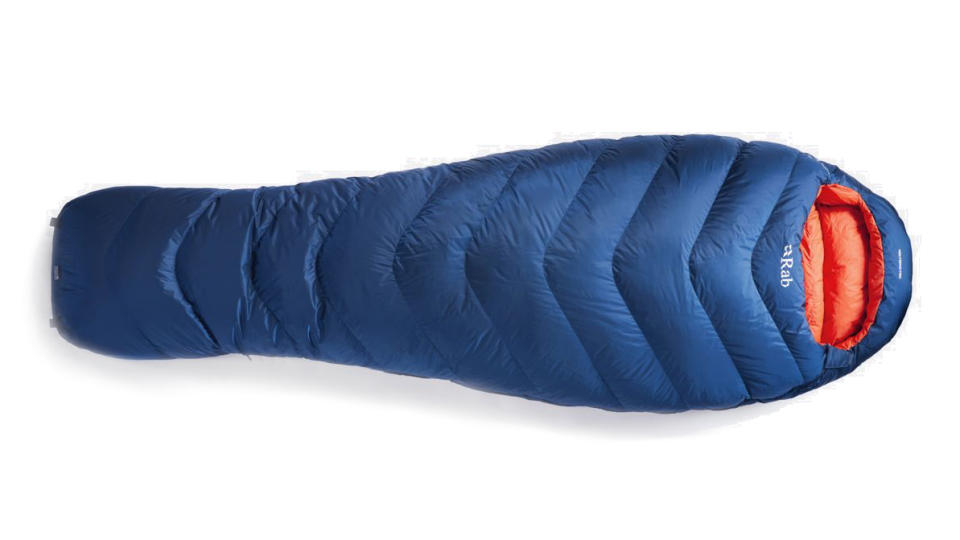
Rab Neutrino Pro 400
A reassuringly snug sleeping bag designed for climbers tackling fast-and-light mountain missions – also the perfect three-season camping cocoon
Weight: 819g/1lb 13oz | Length: 190cm/75in (regular), 205cm/81in (long) | Pack size: 36x19cm/14-7.5in | Fill: Ethically sourced/certified European Goose Down | Comfort limit: -1°C/30°F | Limit: -7°C/14°F
Comfortable, spacious design
Packable and compact
Lightweight
Warm on cold nights
Relatively expensive
Rab’s most recent marketing tagline trumpets the brand as ‘masters of insulation’. That’s a pretty bold claim, but the Neutrino Pro 400 backs it up, seamlessly blending functionality and performance. The high-quality 800 fill power goose down offers impressive warmth for weight as well as packability, reflecting its intended use as a specialist mountaineering piece, where every gram and cubic inch counts. However, it’s too good a bag to be reserved solely for elite climbers, particularly since so many of the features that enable the Pro to excel in high alpine environments mean it is also brilliant for backpackers and wild campers too.
Firstly, the hydrophobic fill and water-resistant shell makes it far more resistant to moisture than most down bags. Generous length and extra room for the upper torso tapering to a contoured footbox means this is a comfortable bag to lie in, whether you’re perched on a rock ledge or not. And even the little details are great, like the handy internal stash pocket or the ‘noctilucent’ zip puller – which means it glows in the dark to you and me. So, we’ll forgive the verbiage and marketing spiel, because this is one of the best sleeping bags around, and delivers on all counts.
Read our full Rab Neutrino Pro 400 review
Best winter sleeping bags
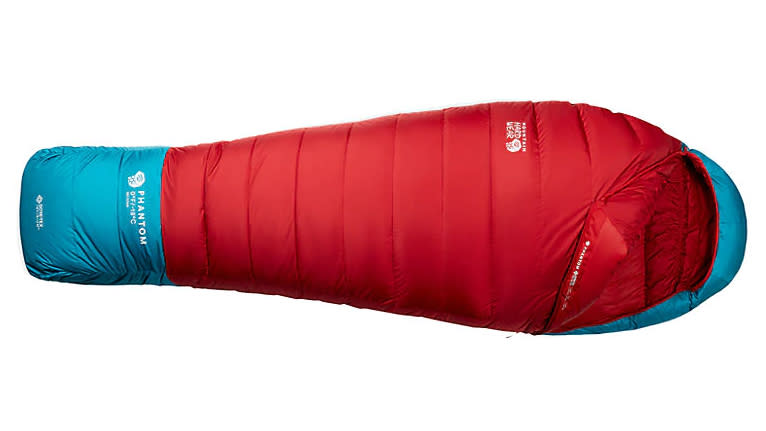
Mountain Hardwear Phantom 0/-18
A seriously warm four-season bag that can only be bested by specialist kit for polar expeditions
Weight: 1kg 208g/2lb 10.6 oz | Length: 218cm/86in (regular), 234cm/92in (long) | Pack size: 21x42cm/8.25x16.5in | Fill: 850-fill goose down | Comfort: -7°C/19.4°F | Limit: -18°C/0.4°F
Exceptionally warm
Lightweight
Expensive
Tapered fit
Down fill not hydrophobic
If you’re a serious winter camper, this tried-and-tested four-season bag could be the best sleeping bag for your next adventure. The flagship sleeping bag in the Mountain Hardwear line, this performance-orientated bag can really only be bettered by niche manufacturers specialising in ultra-premium down kit, which typically come with long lead times and even more eye-watering price tags to match. Given the warmth it offers (down to a bone-chilling -18°c), this bag is lightweight and compact, with an impressively small pack size that ranks among the best in this class. It is filled with a hefty 850g of 850 fill power down, housed in either a Pertex Quantum or Gore-Tex Windstopper fabric shell.
Given its performance-driven design, the fit is highly tapered, maximizing thermal efficiency. As such some might find it a little restrictive, though they would never find it too cold. It has a great neck baffle to lock in warmth along with vertical chest baffles to counter down migration, which could otherwise cause cold spots. The footbox and panelled hood are similarly well-designed. The one rather surprising omission is that the down fill has no hydrophobic treatment, though arguably the highly water-resistant outer would render this unnecessary.
Read our full Mountain Hardwear Phantom 0/-18 review

Rab Solar Eco 3
This super snug sleeping bag utilizes all recycled materials for an ultra warm night’s sleep at an affordable price
Weight: 44 oz / 1235 g | Pack size: 15.7” x 8.7” / 40cm x 22cm | Fill: Synthetic | Comfort: -8F / 20F
Plush and ultra warm, even when wet
Environmentally friendly
Durable construction
Left/right zip options available
Adjustable hood and collar
Too warm for summer camping
A bit heavy and bulky for backpacking
Rab’s Solar collection is its first line of synthetic sleeping bags and the Solar Eco 3 is less than half the price of many of its down sleeping bags. The company known as one of the best in the sleeping bag business doesn’t disappoint with this luxurious-feeling bag, and best of all, it’s environmentally-friendly too.
The Solar Eco 3 is a plush, warm bag packed with synthetic down that continues to insulate when wet, dries quickly and is designed to withstand temperatures as cold as -8F/-20C. This mummy-shaped bag with adjustable hood packs in more down on top, where you need it, with a dual-layer concertina blanket construction that traps loft and warmth. The outer is treated with DWR to repel morning dew, rain-soaked tent walls, and accidental spills in your backpack.
Made entirely using recycled materials, this sleeping bag has a lower impact on the planet, but still manages to be high performing on freezing camping expeditions.
Read our full Rab Solar Eco 3 sleeping bag review
Best multi-purpose sleeping bag
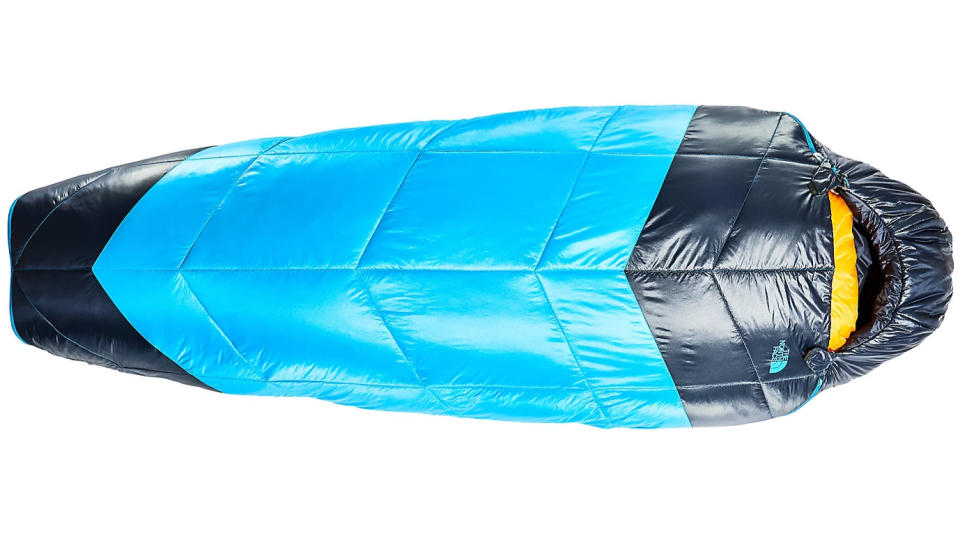
The North Face One Bag
The multitool of the sleeping bag universe
Weight: 1kg 700g / 3 lbs, 12oz | Length: Regular: 198cm / 6ft 6in; Long: 216cm / 7ft 1in | Packsize: 28cm x 36cm / 11 x 14in | Fill: Synthetic outer layer, 800-Fill Goose Down inner layer | Comfort: -1.7°C to 7.8°C / 29°F to 46°F | Limit: -15°C/5°F
Extremely versatile
Offers three ways to sleep
Fleecy stuff sack makes a good pillow
No stash pocket
No women-specific version
Like a three-in-one jacket, North Face’s One Bag sleeping system has interchangeable layers to configure it for 4°C/40°F, -6°C/20°F or -15°C/5°F temps. When you’re road-tripping, camping, or backpacking, whatever the season, the One Bag’s multiple layers combine to keep you warm.
Use the lightweight synthetic outer layer solo on warm summer nights. Add the 800-fill down mid-layer when temps dip. Want to take this bag winter camping? No problem. Use all the layers and the bag will keep you toasty even when it’s down to -15°C/5°F outside. The zippers are color-coded and user-friendly, so it’s easy to add a layer without getting in a tangle. And when you don’t need full insulation, the rolled-up bottom layer makes a great pillow, and the midlayer converts to a shawl for hanging out before it’s time to tuck in. The best sleeping bag for sheer versatility, and one that'll suit almost any camping trip.
Read our full North Face One Bag review
Sleeping bags for comfort
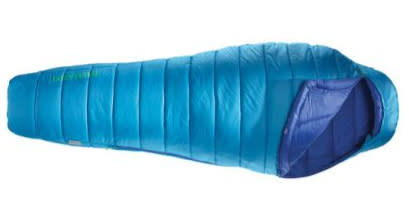
Therm-A-Rest Space Cowboy 45F/7C
For cozy comfort on warm nights where packability isn’t much of an issue
Weight: 1lbs 10oz / 0.72kg | Pack size: 14in x 8in 20cm | Fill: Synthetic | Comfort: 52F / 11C | Limit: 45F / 7C
Soft but sturdy material
Water-resistant insulation
Uses recycled materials
Good value
Not as packable as a down bag
Foot box might be a little tight
Not super breathable
Not suitable for cold nights
Therm-A-Rest tout this sleeping bag as providing worry-free warmth, and at least for summer camping when rain or morning dew are an issue, that’s true. With a comfort rating of 52F/11C and a limit rating of 45F/7C, it does provide ample warmth for summer camping and it’s made from the same soft fabric we’ve come to expect from Therm-A-Rest. Because this bag is made using synthetic down, it has two major advantages: first, it’s quick drying and continues to insulate when wet, so there’s no need to worry about damp mornings, and second, it’s considerably cheaper than down alternatives in the same range.
Now, synthetic bags don’t pack down as much as down, but this one comes in a storage sack that doubles as a stuff sack, and it’s certainly possible to take this backpacking, but the lack of compression straps mean it’s a little bulky, while the packed size is certainly no issue for car camping. The dual-purpose sack also means less materials are used in the production of this bag, which combined with the use of recycled materials makes for a kinder carbon footprint. A nice touch is the addition of two straps that connect to your sleeping pad to keep you from rolling off in the night, improving warmth and comfort. Anti-snag zippers help to improve the durability of this robust bag, and while we wondered if the foot box couldn’t be a little roomier, we think it’s great value for money if you’re seeking a good quality summer bag.
Read our full Therm-A-Rest Space Cowboy 45F/7C review
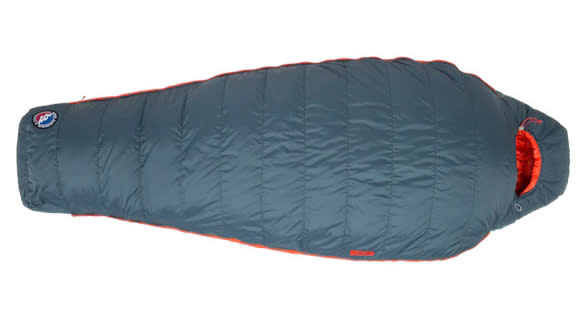
Big Agnes Torchlight 20
A sleeping bag with a clever construction to deliver customized comfort
Weight: Regular 2lb 11oz / 1.22kg Long 3lb / 1.36kg | Pack size: Regular 8.5 x 7.5in / 22 x 19cm Long 8.5 x 8in / 22 x 20cm | Fill: 600 Fill DownTek | Comfort: 27°F/-3°C | Limit: 15°F/-9°C
Expandable panels at shoulder and feet
Customize to your sleep preferences
Available in regular and long
DownTek water repellent down fill
Heavier than comparable models
Do you sleep on your back or your side? Do you move around, or sleep soundly? No matter what sort of sleeping style you have, the Torchlight 20 offers a warm and highly customizable mummy bag that’s light enough for taking backpacking yet cozy enough for 3 to 4 season use.
Offered in a regular and a long size (a women's option is also available), the Torchlight boasts two expanded panels running from shoulder to footbed, which can increase the sleeping space available for your body by 10 inches. When the panels are open, folks with wide hips, wide shoulders and preference for side sleeping will find a warm comfortable sleep system. The bag uses DownTek water repellent down with a baffle construction style to deliver more efficient heat distribution. When temperatures drop, the insulated hood contours to the shape of your face. A stuff sack and off-season storage bag are included.

Sea to Summit Traverse Tv III
Hard-wearing and versatile bag that makes a practical camp companion
Weight : 1kg 440g/oz (regular), 1kg 670g (large) | Length: 203cm/80in (regular), 216cm/85in (large) | Pack size: 36x23cm/14x9in | Fill: Synthetic WaveLoft | Comfort: -4°C/26°F | Limit: -10°C/14°F
Versatile
Roomy
Comfortable
Great ventilation
Basic hood
Not the lightest
Not the most packable
As far as we’re concerned, Aussie brand Sea to Summit don’t make a bad sleeping bag – but the Traverse Tv III is one of their best. It’s the ideal choice for campers who are equally happy to venture out in early spring, late autumn or high summer, as you can zip everything up tight for maximum warmth, but also open all the vents – or even spread the bag out as a full quilt – in milder weather. That versatility makes this an eminently practical bag for varied conditions as well as a good value pick, since you can genuinely use it comfortably throughout all three seasons.
The Traverse Tv III’s supreme adaptability is down to a well-thought-out design that incorporates dual side zips and a foot vent, so you can easily stick out an arm or a foot if you start to overheat. It is cut fairly generously too, with a relaxed rectangular mummy shape that will be appreciated by restless sleepers or by those who don’t like the confined feel of a more tapered mummy-style bag. Inevitably, that accommodating fit adds a little weight and bulk when packed, but it is still a practical size, and one of the best sleeping bags for camping and backpacking.
Read our full Sea to Summit Traverse Tv III review
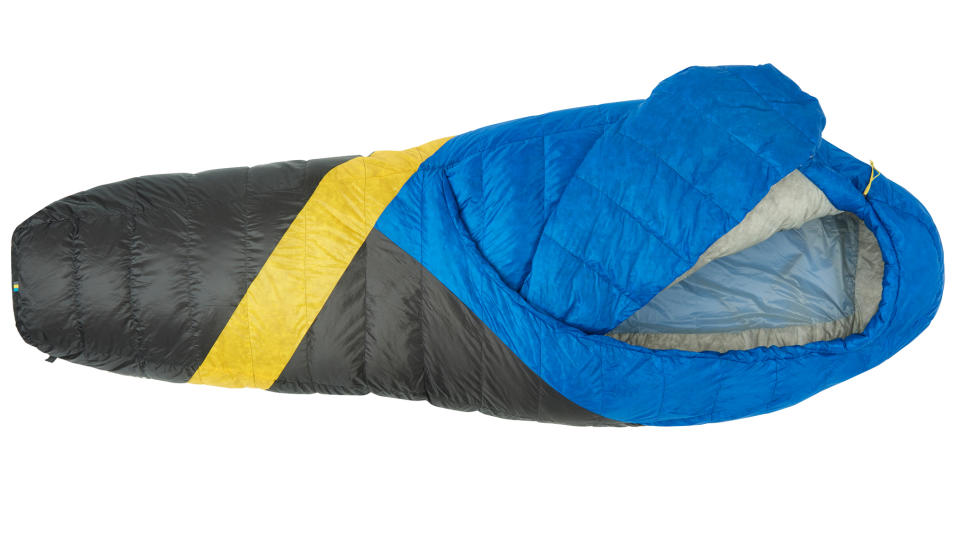
Sierra Designs Cloud 800 35F
An innovative and versatile zipperless sleeping bag
Weight: 660g/1lb 7oz (regular), 710kg/1lb 9oz (long) | Length: 198cm/78in (regular), 213cm/84in (long) | Pack size: 33x18cm/13x7in (regular), 33x18cm/13x7in (long) | Fill: 800FP DriDown duck down | Comfort: 2°C/36°F | Limit: -3°C/26°F
Comfortable
Lightweight
Warm
Well ventilated
Comparatively bulky
Not ideal for side sleepers
Zippers are the chink in every bag’s armour. They add weight and bulk to a bag’s design, have a nasty habit of letting in draughts, and often jam at the worst possible moment. Zips can also be uncomfortable, especially if you get your bag twisted around you. Those drawbacks partly account for the increasing popularity of backpacking quilts, especially in the states. US brand Sierra Designs’ unusual Cloud 800 offers the best of both worlds – the enveloping warmth of a proper footbox and a mummy-style hood in a zipperless design that utilises a quilted flap. It’s a bit like the corner of a duvet but with a shaped shoulder pocket.
The result is a luxurious bag with high thermal efficiency, thanks to box-wall baffles filled with 800 fill power duck down. The half-pad sleeve is also a great innovation, allowing you to secure your sleeping mat in place. The Cloud offers warmth down to -3°C/26°F, but if you do start to overheat, you can kick your feet through a bottom vent to cool down. The bag’s fill is positioned on the top and sides, with a rear sleeve for a sleeping mat. This improves overall warmth for weight and creates a bed-like structure, making this a great two-season bag. If you sleep on your back, you’ll love it, though it’s maybe not such a good option for side sleepers.
Read our full Sierra Designs Cloud 800 35F review
Sleeping bag comparison table
Sleeping bag | Price | Weight | Style | Best use |
Mountain Hardwear Phantom 0/-18 | $760 (US)/£570 (UK) | 1kg 208g/2lb 10.6 oz | 4 season goose down sleeping bag | Winter expeditions, mountaineering, backpacking, wild camping |
Rab Solar Eco 3 | $195 (US) / £155 (UK) | 44 oz / 1235 g | 4 season synthetic down sleeping bag | Winter camping, car camping |
Haglofs Unisex L.I.M +1 | $487 (US) / £350 (UK) | 473g / 1lb 6oz | 2 season goose down sleeping bag | Wild camping, fastpacking and mountain marathons in warm weather |
Therm-A-Rest Vesper 32 Quilt | $329 (US) / £285 (UK); Long: $349 (US) / £305 (UK) | Regular 425g / 15 oz; Long: 490g / 1lb 1oz | 2 season goose down camping quilt | Fastpacking, bikepacking and ultralight expeditions in warmer months |
Rab Neutrino Pro 400 | £355 (UK) | 819g/1lb 13oz | 3 season goose down sleeping bag | Backpacking, bikepacking, wild camping, mountaineering expeditions in the warmer months |
North Face One Bag | $300 (US) / £315 (UK) | 1kg 700g / 3 lbs, 12oz | 4 season goose down versatile sleeping bag | Multiple configurations make it perfect for the full range of scenarios |
Therm-A-Rest Space Cowboy 45F/7C | $150 (US) / £125 (UK) | 1lbs 10oz / 0.72kg | 3 season synthetic sleeping bag | Summer camping, car camping |
Big Agnes Torchlight 20 | $300 (US) / £375 (UK) | Regular 2lb 11oz / 1.22kg Long 3lb / 1.36kg | 3 season synthetic down sleeping bag | Backpacking, bikepacking, wild camping |
Cotopaxi Sue?o | $350 (US) / £300 (UK) / €420 (EU) | 2lb 13oz / 1276g | 3 season duck down sleeping bag | Backpacking, bikepacking, wild camping |
Mountain Equipment Firefly | $450 (US) / £360 (UK) | 560g/1lb 4oz (regular), 600g/1lb 5oz (long) | 2 season good down sleeping bag | Fastpacking, bikepacking and ultralight expeditions in warmer months |
Sea to Summit Traverse Tv III | $200 (US)/£200 (UK) | 1kg 440g/oz (regular), 1kg 670g (large) | 3 to 4 season synthetic down sleeping bag | Backpacking, bikepacking, car camping |
Sierra Designs Cloud 800 35F | $300-320 (US)/£260 (UK) | 660g/1lb 7oz (regular), 710kg/1lb 9oz (long) | 2 season duck down sleeping bag | Backpacking, bikepacking and ultralight expeditions in warmer months |
How we test the best sleeping bags
At Advnture we endeavor to test every product we feature extensively in the field. That means one of our team of reviewers and writers – all experienced outdoor specialists active across the US, UK, Europe and Australasia – taking it out into the terrain and climatic conditions that it’s designed for. If, for any reason, this isn’t possible, we’ll say so in our buying guides and reviews.
Our reviewers test sleeping bags overnight in outdoor conditions and temperatures appropriate to the rating assigned to the product by the manufacturers/ brand. Specific features (weight, warmth, loft, zip quality, hood, footroom, packability and so on) are tested against claims made by the brand. They will also carry the sleeping bag in a backpacking scenario to test its performance during multiday hikes.
For more details, see how Advnture tests products.
Choosing the best sleeping bag for you
When considering the purchase of a sleeping bag, there are many factors that will dictate which is the best option for you. Your budget, you intended use and the environment you'll be exploring all have to be taken into account.
If you're going to be spending part of the summer in a family tent with the little ones, you may not need to dive too deep into the wallet. However, if you're spending a week on expedition across wild country, you'll need something both warm and lightweight.
Everyone's ambitions are different, so there's a different best sleeping bag for everyone. In general, however, it’s worth considering the following:
1. Performance
Most bags are given a season rating: a three-season bag is suitable for spring, summer and autumn use, for example. They also have a temperature range typically including an upper limit, a comfort limit, a lower limit and an extreme limit. The comfort and lower limits are the best indicators of a bag’s realistic temperature range, but they should only be used as a guide. If you have wild camping ambitions, or are planning to sleep in a hammock, it is best to go for a sleeping bag with a low comfort limit.
As with the best down jackets, the major factor affecting warmth is the fill, which will be either synthetic insulation or natural down. Generally, down sleeping bags offer superior warmth-to-weight, but down’s performance declines markedly if it gets wet. Synthetic bags continue to insulate even when damp, and they’re more hard-wearing, easier to care for, and cheaper.

2. Features and fabrics
Most premium bags use a box wall construction, which traps the fill inside brick-shaped baffles. Larger baffles give more space for insulation to loft but can be prone to down migration (when the fill shifts around, causing cold spots). Smaller baffles stop this. Simpler bags generally use a stitch-through construction, which isn’t as thermally efficient, but does save weight. Some synthetic bags use a baffle-free construction that instead employs a single sheet of insulation, which minimises stitching for improved durability and helps to reduce cold spots.
A well-insulated, close-fitting and adjustable hood really helps lock in heat. Hood drawcords enable you to cinch in and customise the fit around your face, but ensure they’re comfortably placed and easy to use. A chunky neck or shoulder baffle helps to prevent warm air from escaping too.
Shells and linings are usually made from ripstop nylon, though cheaper bags use polyester. Both are soft on the skin, but nylon is generally more durable as it is a stronger fibre for its weight.
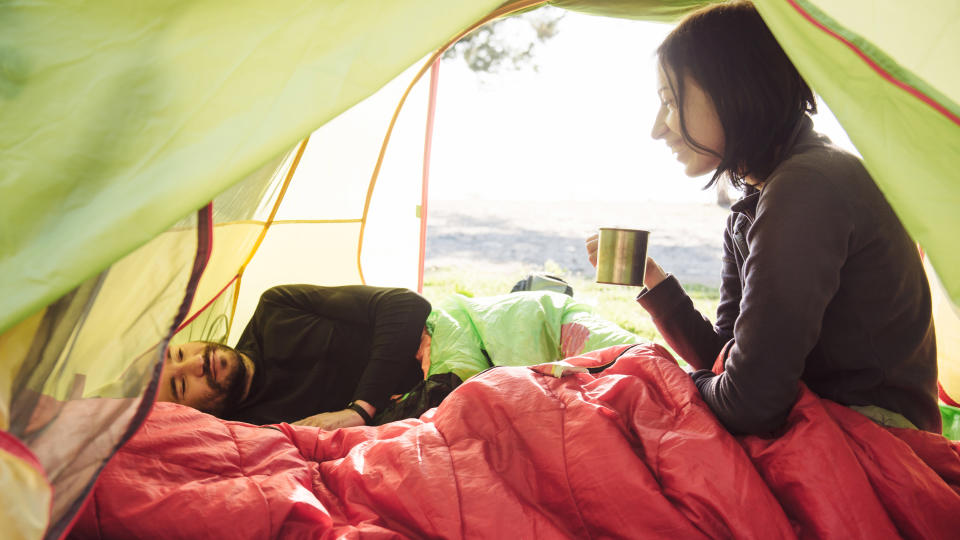
3. Zips and vents
A long zipper makes for easier entry and exit, and also provides ventilation in warmer weather, especially if it has two-way zip pullers. However, a shorter zipper saves weight and reduces bulk, so is often a feature of ultralight bags. Many of the best sleeping bags are available with either left- or right-hand zips. If you’re a side sleeper, think about which side you usually sleep on, as having a zip underneath you can be uncomfortable and impractical. Zippers are notorious for letting in chills, so ensure they’re backed with padded baffles.
In some situations you can overheat, which is almost as unpleasant as being cold. To mitigate this, many bags have vents or gills – usually at the foot end, but occasionally at the sides too.
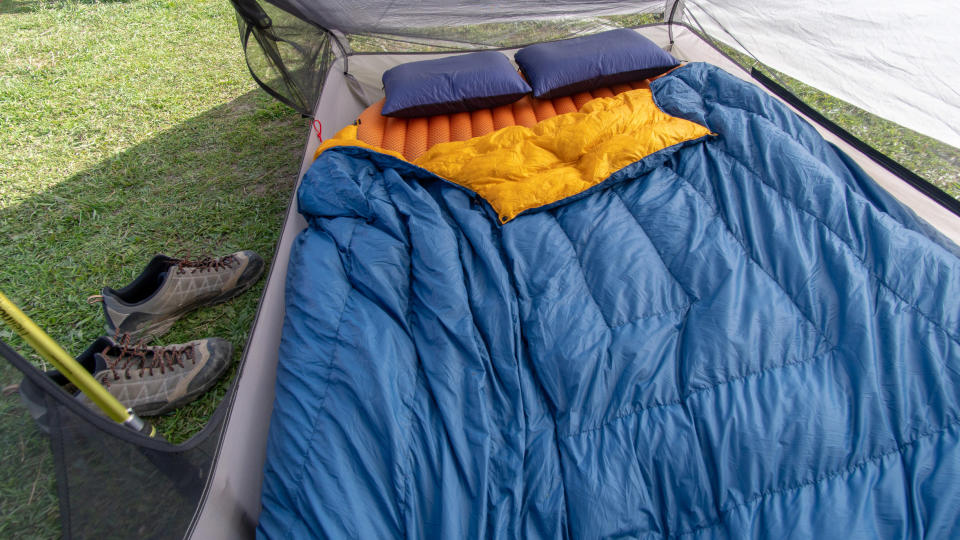
4. Size and comfort
The best sleeping bag should be available in different lengths or even widths, as well as women-specific fits. Check the specs of a bag to find out which is right for your height and body shape. Technical or ‘performance mummy’ bags are slim fitting and highly tapered for maximum thermal efficiency. Some people find them restrictive and may prefer a more relaxed shape, which gives extra wriggle room. Some bags are also elasticated to give you more room to move around, without reducing their effective warmth.
It should go without saying, but no matter how comfy or warm your bag is, it will all be for naught if you don't have a sleeping pad or mat underneath. A sleeping pad insulates you from the ground below, leading to greater warmth and comfort. A camping pillow will also make for a much easier night's sleep, without taking up to much room in your pack.
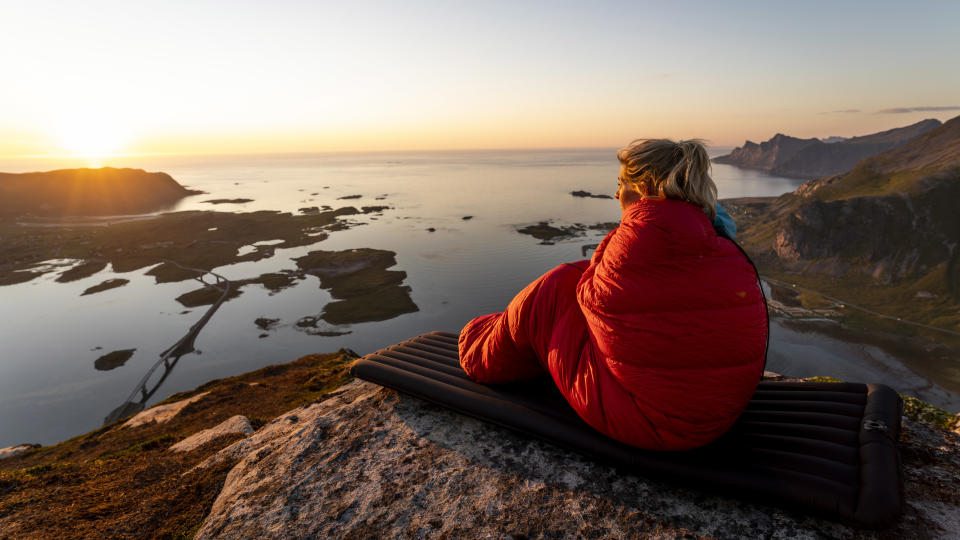
5. Weight and pack size
Depending on your intended use, weight and pack size may be absolutely critical or less important. But a lightweight bag with a small pack size is obviously easier to carry, which you'll thank yourself for if thru-hiking for any considerable distance. Most bags are supplied with a stuff sack, but these vary in quality. A stuff sack that is fitted with compression straps will really help to cinch down the pack size. Remember – you can always buy a compression sack for your bag if necessary, or you may want to store it in a dry bag.
In addition to a stuff sack, many of the finest bags now come with a larger cotton storage sack that allows the bag to loft and breathe when not in use. This prevents musty odours and damage to the fill caused by long-term compression.
As a rule of thumb, a good two-season sleeping bag should weigh under a kilo (2.2lbs). You can find lightweight down three-season sleeping bags that deliver additional warmth for similar weight, but others may tip the scales at up to 2kg (4.4lbs).
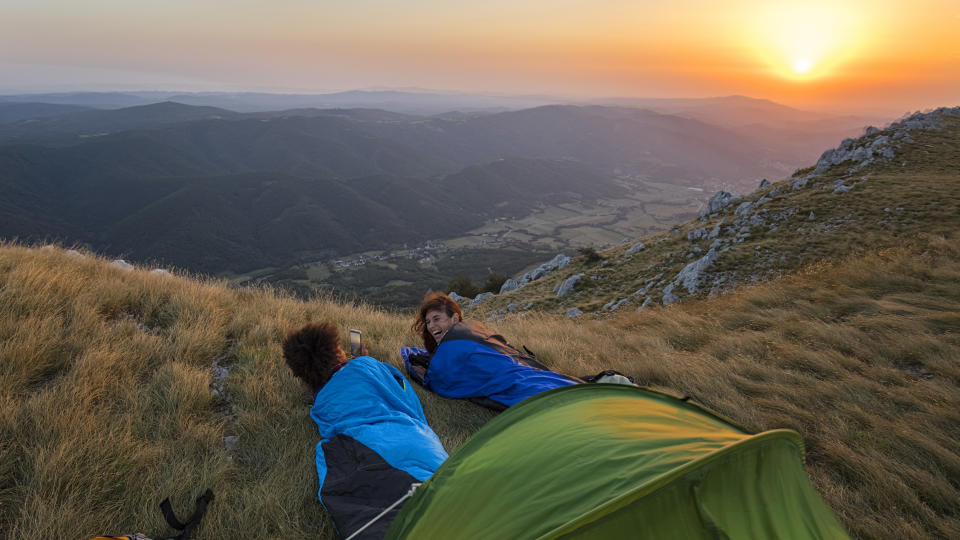
6. Value
Considered in terms of lifetime use, a high-quality down bag can offer very good value, provided you look after it. Down tends to suffer less from long-term compression compared to synthetic fills. Synthetic bags are generally cheaper and can still offer good overall performance, and in some cases come with only a minor increase in weight and bulk.
Sleeping bag prices vary widely. The cheapest bags start at around $35/£25, the most expensive might be $500/£500+. You can expect to pay more for better insulation, but you’ll also pay more for bags that offer exceptional warmth to weight. Invariably, these will use down with an extremely high fill power (800FP or more). Lower grade down bags are cheaper, but usually still more expensive than a synthetic alternative. As always, shop around – you can almost always pick up sleeping bags for far less than the RRP.
